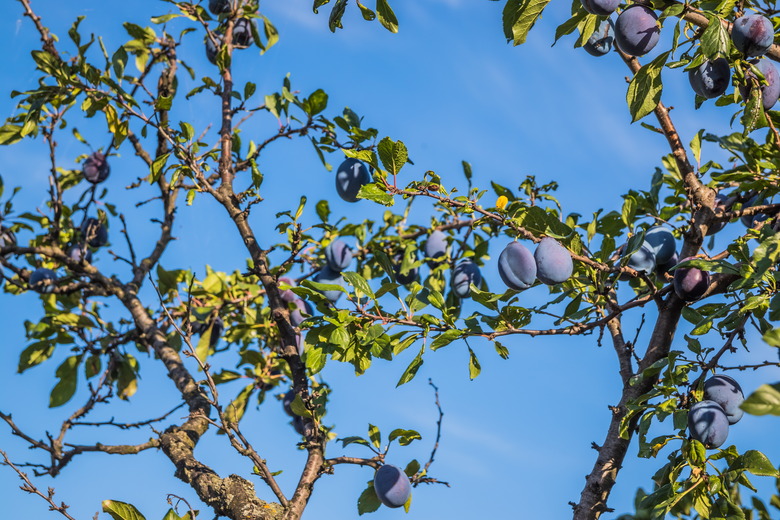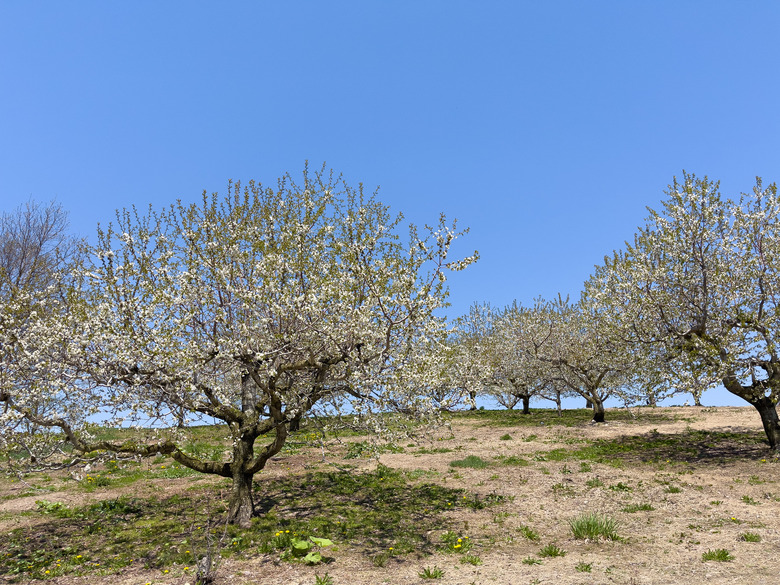How To Prune A Plum Tree
Plum trees (Prunus spp.) are easy-care fruit trees and are highly ornamental with their ethereal spring blossoms. This stone fruit species gets relatively large. Most plum trees require another plum tree cultivar nearby as a pollinator for fruit production. All need full sunshine to bring that crop to maturity. There are two different kinds of plums: early blooming Japanese plums (Prunus salicina) and European or common plums (Prunus domestica). Plums ripen in late summer to early fall depending on the cultivar and climate.
Pruning plum trees during the dormant season is essential to maintain the tree's shape; to allow adequate light into the canopy; and to create healthy, fruiting wood. Since Japanese and European plums have different natural shapes, they are pruned differently.
Species of Plum Trees
Species of Plum Trees
Several types of plum are grown in the United States, most commonly the European plum and the Japanese plum. These species, though both plum trees, have significant differences. The two species thrive in different conditions, have different natural branching structures, and require different types of pruning. For example, Japanese plums bloom in late spring, and European plums bloom up to two weeks later.
European plums are upright trees that do best with a modified central leader branch structure. The fruits develop a higher sugar content than other plums, which makes most of these cultivars better for eating fresh because of their sweet and juicy fruit. The fruit of "prune" cultivars of European plums is suitable for drying and other types of processing such as making jams and jellies. European plums thrive in USDA plant hardiness zones 5 to 8 and are more productive with another European plum cultivar nearby as a pollinizer.
Japanese plum tree canopies are more rounded and spreading than European plums. They have a natural vase shape, so this species is best grown with an open center branch structure. Their large fruit is juicy, with skin color ranging from yellow to red to near black, and Japanese plums are usually eaten as fresh fruit, although some cultivars are better for making jams and jellies. Grow these trees in zones 5 to 9 near another Japanese cultivar for pollination, because European plum pollen is incompatible with Japanese plums.
How to Train Plum Trees
How to Train Plum Trees
Pruning fruit trees often starts with training, which means pruning young plum trees during their first years to create a strong and suitable branch shape. For European plums, this will be a modified central leader shape for the new tree. For Japanese plums, this will be an open center structure. Training for the two species is similar.
- Young nursery trees with thin trunks usually do not have lateral branches. Prune these back to between 18 and 24 inches
above ground level in early summer.
Use a clean, sharp, sterilized pruner, pair of loppers, or pruning saw.
Primary or scaffold branches will develop 6 to 10
inches below this cut.
- Toward midsummer, select four side shoots (young lateral branches), strong lateral shoots that
are spaced evenly around the main stem. Those shoots will develop into the four scaffold branches that
will be the main branches of the tree. - If your nursery trees have a central stem greater than 1/2 inch
diameter, they likely already have side branches. Remove most of these branches, leaving about four strong shoots around the trunk at about a 45-degree angle from the trunk and evenly spaced in a north, south, east, and west direction. - Cut back the remaining lateral branches 2 to 3 inches or closer to the trunk to stimulate
vigorous lateral growth. - During the summer of the second year, prune out any branches below
the four
scaffolds flush against the center stem. The remaining scaffold
branches, aka a scaffold whorl, provide structure and keep the
tree's shape balanced. Cut back each of these branches to leave only a
few healthy buds, making the pruning cuts above the buds. - Remove all of the new shoots that arise from the root
system around the base of the tree, termed suckers. Cut them off at ground level to direct the tree's
energy into the main tree trunk.
How to Prune a Plum Tree: European Plum
How to Prune a Plum Tree: European Plum
Pruning plum trees after training is a matter of creating a strong and suitable branch shape on which the tree can bear fruit. For European plums, this will be a modified central leader shape for the new tree. Central leader pruning is used for trees that have more of an upright growth habit and involves a central upright trunk surrounded by successive spires of lateral branches. The modified central leader system's framework is dependent on four lateral branches spaced evenly around the trunk. The lowest set of lateral branches should be at least 24 inches above the ground. Each lateral should occupy a specified section of the tree.
For European plum trees, favor thinning cuts that encourage spreading outward-growing branches so that sunlight can penetrate the inner canopy and enhance fruit spur production. Thinning cuts are clean cuts made just above an outward-facing bud using a sharp cutting blade.
Begin annual pruning by cutting out any dead, diseased, or damaged branches. For mature trees, continue pruning to take out about a quarter of the branches to allow light penetration, increase fruit quality, and encourage new branch development. Plums produce the most fruit on short spurs on wood that is two to five years old. Remove suckers (shoots coming from the roots or on the stem below the graft) on a regular basis.
How to Prune a Plum Tree: Japanese Plum
How to Prune a Plum Tree: Japanese Plum
Japanese plums are pruned using the open center system. This also requires the selection of scaffold branches, with the lowest set of branches at least 24 to 30 inches above the ground. Unlike the central leader system, the central stem or trunk must be removed completely. Do this the year after the scaffolding branches are selected. At the same time you prune all the branches in the center of the tree, remove branches below the four scaffolds.
Repeat this annually to maintain the open vase shape. Annual pruning involves many of the same early steps, like cutting out dead wood, breakage, and thinning branches to allow sunlight to penetrate the canopy.

